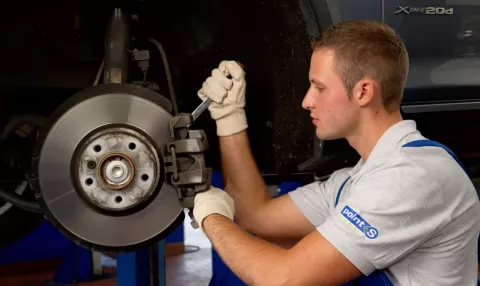Wheel alignment and balancing
Many drivers underestimate the impact of wheel alignment can make to the driving experience. In this guide, our aim is to show you the importance of perfect geometry on your car and the consequences of its absence.

Many drivers underestimate the impact of wheel alignment can make to the driving experience. In this guide, our aim is to show you the importance of perfect geometry on your car and the consequences of its absence.
What is wheel alignment?
Wheel alignment is the study of adjusting the design angles of a car running gear. Many confuse or associate the notions of geometry and parallelism, wrongly. Indeed, parallelism is only one component of wheel alignment. Thus, the geometry results from the combination of three main angle studies concerning the wheels of your vehicle:
Toe-toe angle à parallelism: It’s the study of the angle of the opening of wheels between them and with the road, seen from above. It must be adjusted correctly for the vehicle to deploy its full performance in terms of grip. The key symptom of faulty parallelism is the smooth and uncontrolled shift of your vehicle to one side of the road when you are in a straight line.
Camber angle: this is the study of the contact inclination angle between wheels and road, seen from the front. This adjustment is necessary in order to reduce your tyre wear. Indeed, the symptom of a badly adjusted camber is a significant wear on the inside or the outside of your tyre, depending on the positive or negative inclination of your wheel.
Caster angle: The caster angle is the angular displacement of the steering axis from the vertical axis of a steered wheel in vehicle, measured in the longitudinal direction. It is the angle between the pivot line and vertical. This setting defines the stability of your car at high speeds and improves your steering angles. Its natural disruption is rare, but it’s advisable to carry out a check after an accident in particular. The key symptom of a bad caster angle is a modified steering, either harder or with a crying lack of responsiveness depending on the disorder.
When should you have a wheel alignment?
A small faulty adjustment can have a clear impact on your vehicle behaviour, which is why it’s essential to always have perfect wheel alignment and regularly updated. Indeed, very slight external disturbances can disturb the camber and the parallelism of your wheels. Therefore, always be sure to make your vehicle checked in the following situations:
- A traffic accident, even very slight, as an impact with a sidewalk
- Various driving anomalies:
- Direction pulling to one side
- Abnormally stiff steering wheel after a turn
- Tyres that wear strangely quickly and irregularly
- When installing new tyres on a used car
All these points of vigilance are alerts of faulty wheel alignment and can disappear very quickly while increasing your driving comfort.
For lovers of technique
To adjust these items, your Point S experts will use 3D wheel alignment technology. The principle is as follows: callipers will be placed on each component of the vehicle running gear; a laser will then be sent to these callipers and reflected in order to calculate the various angles to the nearest tenth of a mm.
After your expert gathered these information, he will only have to make the necessary adjustments to make your vehicle perfectly balanced to give it all the performance it can deliver and the comfort you deserve.
Instant budget
The price of a complete wheel alignment is relatively variable, it's depend on the vehicle and the depth of the service that will be performed.
Overall, we can only advise you to invest in a regularly rebuilt geometry because it will allow you in a long term to make real savings in terms of fuel consumption and tyre wear. In addition, you will also benefit from a safer vehicle with better handling.
We recommend you to check your wheel alignment at least once a year or as soon as you notice any of the symptoms mentioned in this article.
Also think about tyre balancing
Balancing is a study of the overall weight distribution of the wheel / tyre set. The aim is to distribute the masses evenly to make your car and tyres as balanced as possible. The main symptom of faulty balancing is wheel vibration, which can cause a quicker wear of your tyre bandwidth.
Remember to request a balancing of your wheel / tyre set each time you change your vehicle tyres to prolong the tyre life. Of course, as stated just above, if you feel vibrations while driving, contact a specialist as soon as possible so as not to damage your tyres too much.
For more advice and information about wheel alignment, wheels and other automobile subjects please check our different articles and our geometry and parallelism service.
* This price represents an estimated average of the prices charged for the service, they are not contractual and do not apply to the Point S network.
** This price represents an estimated average of the prices charged for the service, they are not contractual and do not apply to the Point S network.


